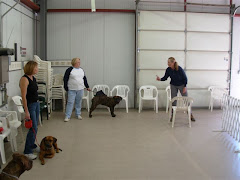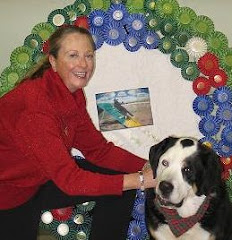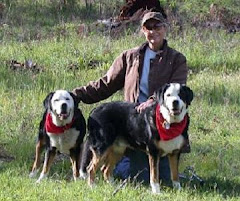
Polly's the Great Pyrennees who lives at the top of the hill. She lives a fairly miserable existence, chained inside a goat pen where she "guards" the herd of goats. In Montana, by the way, people keep goats for one main purpose: to eat knapweed. When the knapweed's not in season, the goats are penned and fed hay.
So Polly's full-time job is to watch over the goats. She's chained in the pen because she digs out otherwise, leaving an escape hatch for the goats.
Her caretakers are clueless about dogs and had described her to me as sweet and affectionate around people and kids, but a killer around other dogs and four-legged critters. And as huge and boisterous as she was, she certainly couldn't be taken for walks. "She'll take you, maybe!" her owner had said with a sarcastic wink.
Well, Polly's getting her walks this week. I'm babysitting her in their absence. Twice a day I hike up the hill to her place. I put a good quality choke chain on her and use my short handle leash from Ezydog, and away we go on our march, with me in the lead all the way. It's a miraculous exercise, this 20 minutes I spend migrating down our country road with her on one side of me and Lizzie on the other. When we get back, Polly is a different dog. She never has been the killer her owners think she is; she's a perfectly normal dog. But after our walk, she's subdued, relaxed, submissive, and calm. She's putty in anyone's hands, and not the least bit interested in challenging anyone.
I thank Cesar Millan, "The Dog Whisperer," for stressing and explaining this miraculous walking exercise. The only activity that's more powerful in forming that human/canine bond is my own "Leadership Game." The Walk, however, is an indispensable supplement.
Let's review what you need for this dog-altering experience:
1. A quality choke chain, not too loose. It should be up high on the neck ("Like in dog show," as Cesar would say).
2. A short leash that allows you to walk with your leash-holding arm TOTALLY EXTENDED STRAIGHT DOWN and relaxed. In this position, you should be able to hold your dog's neck DIRECTLY at your leg, with the collar (but not the leash) hanging loose. Adjust the length of the leash in your hands so you're able to make the collar jingle with just a flick of your wrist.
The absolutely perfect leash for this exercise is the EZYDog handle leash. It is so unbelievably comfortable and secure in your hand that you can forget about the leash and put your energy into WALKING instead of protecting your hand. This leash is probably the single-best training device I've found in 20 years.
Now, to start the walk: watch your posture. Stand upright, shoulders back, head up, and walk. The dog at your side is going with you, one way or another. Walk with energy, pride, and confidence, as if you're master of the planet. Don't stop if the dog slows down or wants to stop. Keep going. The dog will learn that you're in charge. He can sniff and pee later, when you decide to rest. If he starts to lag, or zigzag, correct him with a light but sharp "zip" of the leash. Let the collar, not your arm, do the work in communicating your desires. The audible "cha-chink!" is very effective. Maintain your straightforward pace as long and as far as you can, out and back.
Cesar says the dog's three basic daily needs are
1. exercise
2. discipline
3. affection
To provide all three in one session with Polly, we walk first. Next, I prepare her food dish and ask her to sit while I'm doing so. Finally, I provide her with food and petting.
A word about the food: her caretakers provide Polly and their two other stock dogs with whatever is the cheapest dog food they can find that week. Right now it's a 50-pound bag of Western Family dog kibble. These dogs HATE this food. We put it out for the two stock dogs, and the plate of food will sit there all day. Finally, when they become desperately hungry, they'll go to the bowl and gingerly choke it down. I don't blame them. The food LOOKS awful (all that food coloring, yuck), smells and feels horrible (it's coated with rancid grease from rendering plants and restaurants). When I take care of Polly, she gets a special treat: Flint River Ranch. Polly would let the Western Family crap sit all day too, but now she sees me arrive with the "good stuff" and starts leaping for pure joy. She eats it all IMMEDIATELY and looks around for more. I've given a few handfuls to the stock dogs too, who literally inhale it out of my hand (while the Western Family sits in their bowl all day). I frankly can't afford to treat all three dogs to Flint River, so I'll give it to Polly because I feel the most sorry for her.
I've tried to convince the owners they should get a better food, but they're old-fashioned and think that as long as their dogs have fairly shiny hair and enough energy to keep working, that they're getting adequate nutrition. Granted, there've been many dogs who have survived 15 years on Purina Dog Chow or worse. But to me, part of the joy of having a dog is in seeing the joy we can bring to them. The joy I see on these poor dogs' faces when I hand them Flint River makes it worth the expense.
As my husband put it last night when he watched their reactions, "It's probably like coming in to a prime rib dinner after eating C-Rations for six months."


















No comments:
Post a Comment